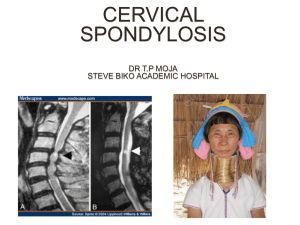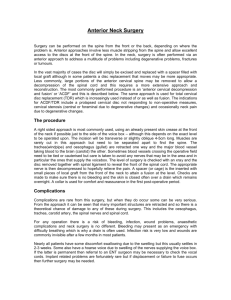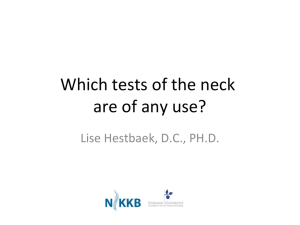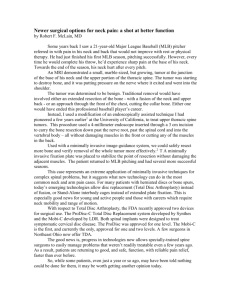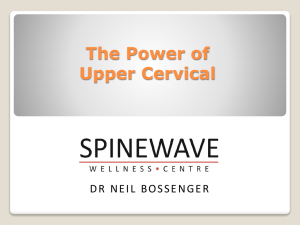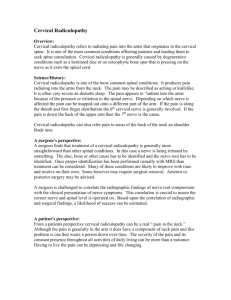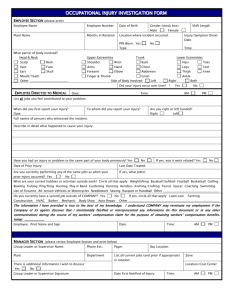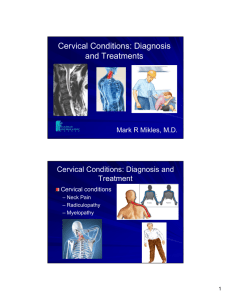Neck Pain - UBC Wiki
advertisement
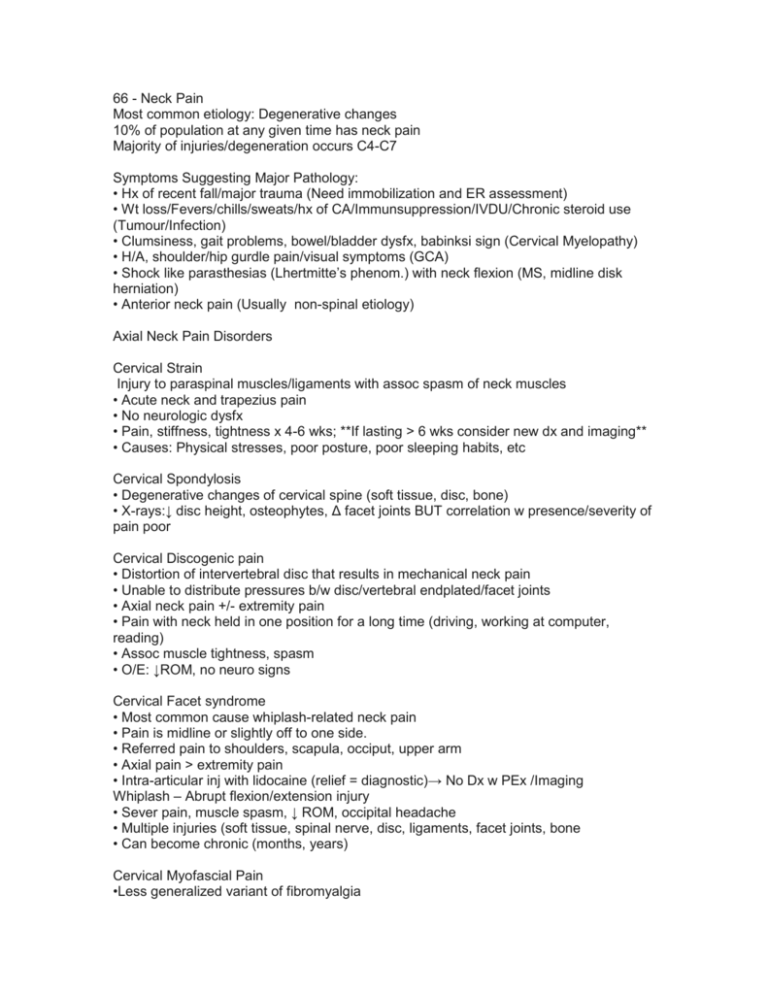
66 - Neck Pain Most common etiology: Degenerative changes 10% of population at any given time has neck pain Majority of injuries/degeneration occurs C4-C7 Symptoms Suggesting Major Pathology: • Hx of recent fall/major trauma (Need immobilization and ER assessment) • Wt loss/Fevers/chills/sweats/hx of CA/Immunsuppression/IVDU/Chronic steroid use (Tumour/Infection) • Clumsiness, gait problems, bowel/bladder dysfx, babinksi sign (Cervical Myelopathy) • H/A, shoulder/hip gurdle pain/visual symptoms (GCA) • Shock like parasthesias (Lhertmitte’s phenom.) with neck flexion (MS, midline disk herniation) • Anterior neck pain (Usually non-spinal etiology) Axial Neck Pain Disorders Cervical Strain Injury to paraspinal muscles/ligaments with assoc spasm of neck muscles • Acute neck and trapezius pain • No neurologic dysfx • Pain, stiffness, tightness x 4-6 wks; **If lasting > 6 wks consider new dx and imaging** • Causes: Physical stresses, poor posture, poor sleeping habits, etc Cervical Spondylosis • Degenerative changes of cervical spine (soft tissue, disc, bone) • X-rays:↓ disc height, osteophytes, Δ facet joints BUT correlation w presence/severity of pain poor Cervical Discogenic pain • Distortion of intervertebral disc that results in mechanical neck pain • Unable to distribute pressures b/w disc/vertebral endplated/facet joints • Axial neck pain +/- extremity pain • Pain with neck held in one position for a long time (driving, working at computer, reading) • Assoc muscle tightness, spasm • O/E: ↓ROM, no neuro signs Cervical Facet syndrome • Most common cause whiplash-related neck pain • Pain is midline or slightly off to one side. • Referred pain to shoulders, scapula, occiput, upper arm • Axial pain > extremity pain • Intra-articular inj with lidocaine (relief = diagnostic)→ No Dx w PEx /Imaging Whiplash – Abrupt flexion/extension injury • Sever pain, muscle spasm, ↓ ROM, occipital headache • Multiple injuries (soft tissue, spinal nerve, disc, ligaments, facet joints, bone • Can become chronic (months, years) Cervical Myofascial Pain •Less generalized variant of fibromyalgia •Regional pain assoc with trigger points, tight bands, pressure sensitivity • Assoc with depression, insomnia DISH (Diffuse Skeletal Hyperostosis) • Inappropriate calcification @ insertion of ligament/tendon • Dx on X-rays – specific changes • Stiffness, loss of mobility Tx Axial Neck Pain: •Acute (<6 wks): Acetaminophen, NSAIDS, mild opioids (eg.tramadol), muscle relaxants (cyclobenzaprine 5mg TID, benzos); Home exercises: Gentle stretching exercises incl shoulder rolls and neck stretches (heat neck prior); Persistent (>6wks): Physical Tx, TCA’s (amitryptyline/nortryptyline 10-30 mg QHS), duloxetine/venlafaxine esp w depression/anxiety/fibromyalgia Extremity Pain / Neurologic Deficit Disorders Cervical Spondylotic Myelopathy – Narrowing of the spinal canal → SC injury/dysfunction • Sx: Weakness, stiffness in L/E, poor coordination / gait imbalance, bowel/bladder dysfx (rare), sexual dysfx. • Signs: atrophy of hands, hyperreflexia, Lhermitte’s sign, sensory loss • DDx: MS, tumour, epidural abscess, ALS, syringomyelia **Needs surgical decompression*** Cervical Radiculopathy – Dysfunction of spinal nerve root • Pain, weakness, sensory changes, reflex changes along particular nerve root • DDx: Degenerative/foraminal stenosis/herniated disc >> Shingles, DM radiculopathy • Tx: analgesics, ?prednisone short course? Non Spinal Causes • Thoracic Outlet Syndrome – Triad:1)Numbness, 2)weakness, 3)sensation of swelling in upper limb • Shingles – unilateral pain followed by typical rash • Diabetic Neuropathy • Vascular: vertebral artery/carotid artery dissection • CVS: angina, MI • INfxn: pharyngeal abscess, meningitis, HZV, Lyme D. • Rheum: RA, PMR, fibromyalgia, spondyloarthritis • Neuro: cervical dystonia, tension H/A Physical Exam Inspection ROM Palpate paraspinal & trapezius Neuro exam: motor, sensory, reflexes, gait UMN signs? - ↑ Reflexes, ↑ tone/spasticity, ↑babinski Special Tests Spurling’s (Neck Compression Test) – For ? radicular pain • Head in neutral position → press down on top of head • Head rotated to affected side and hyper extended → neck compression • Reproduction of sx beyond shoulder is +ve test • C/I in RA, cervical malformations, metastatic Upper Limb Tension Test – For ? radicular pain •Head turned contralaterally, ipsilateral arm abducted, external rot, wrist ext •Reproduction of arm sx is +ve test, used as tx? Manual Neck Distraction Test Hoffman Sign – indicates myelopathy Shoulder Abduction relief test – indicates herniation/nerve root imping, and therapeutic Imaging X-ray (odontoid, lateral, PA, both obliques) • Hx of neck trauma • New symptoms in patients >50y CT/MRI • Neurologic impairment • Constitutional sx (fevers, chills, wght loss) • Dramatic bony tenderness with impaired mobility • Persistent symptoms after 6 weeks of conservative care EMG • Pain, dysesthesias more prominent in extremities • not very useful for CSM, may help differentiate radiculopathy from peripheral nerve entrapment Trauma Immobilization, neurological assessment, spinal palpation, radiographic studies Clearing C-spine: Clinical • No C-spine tenderness • No evidence of intoxication • Alert and oriented (GCS=15) • No focal neurological deficit • No painful distracting injury Lateral Alignment Anterior longitudinal line Posterior longitudinal line Spinolaminal line Spinous processes Ligamentous injury / instability Bone (evaluate each vertebrae - ?Fracture, inc/dec density) • Cortex – no discontinuity, angulation, step-off, bowing • Dens – Difficult to see on lateral view. Atlanto-occipital dislocation Cartilage / connective tissue • Joint spaces Soft Tissue • Predental space should be <3 mm in adult, <5 mm in children • Pre-vertebral space should be no more than 1/3 the diameter of the vertebral body

